Reviews
For a Politically Fraught Istanbul Biennial, Elmgreen & Dragset Rely on Metaphor to Sidestep Direct Confrontation
The metaphor of the neighbor is one of the big ones.
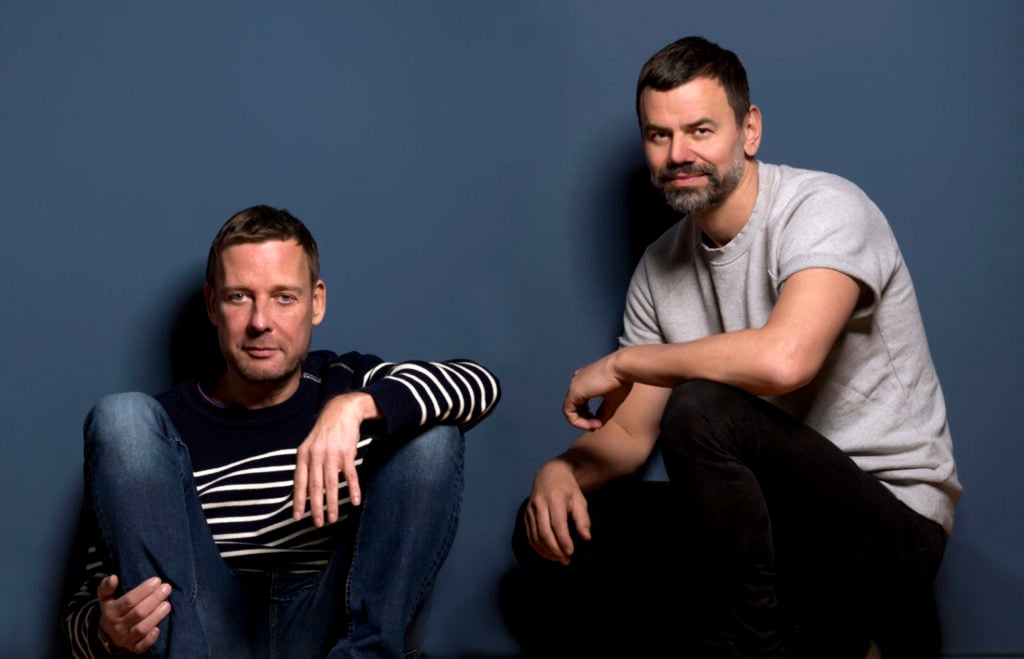
The metaphor of the neighbor is one of the big ones.

Hili Perlson

Michael Elmgreen and Ingar Dragset, the curators of this year’s Istanbul Biennial, stand for a signature approach of narrativistic subversions and installative sleights of hand, a technique they aptly and consistently use to convey messages that are anti-simplistic in nature. But in the age of bullies-as-politicians and group-thinking boycotters, complexity has in itself become a political cause that needs to be celebrated, protected, and given ample space to be experienced.
Tasked with staging a major international exhibition in Turkey at a time of especially fraught political and human rights developments, the central question the two artists-curators faced was: How can one carve a space wide enough for the biennial and its artworks to unfold, rather then be forced through a narrow filter tinted by the latest headlines?
For the Danish-Norwegian duo, the answer was metaphor. Titled “a good neighbor,” the 15th Istanbul biennial asks what does it mean to, simply, coexist. The question—which appears in lowercase on billboards all across the city on the Bosporus and around the world (in a collaboration with a slew of international art spaces)—is presented as an incomplete sentence, as Michael Elmgreen explained at the biennial’s press conference, and most likely one ending with a question mark.
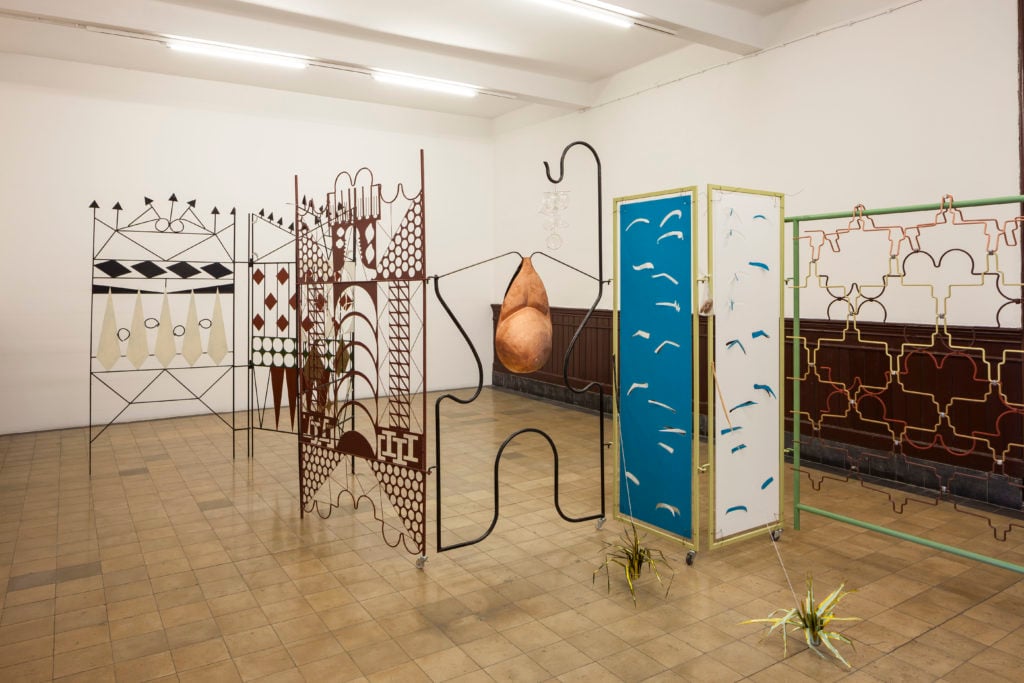
Kasia Fudakowski, Continuouslessness, (2011–17). Mixed-media installation. Dimensions variable. Courtesy of the artist and ChertLüdde (Berlin) Produced with the support of Adam Mickiewicz Institute. Presented with the support of the Institut für Auslandsbeziehungen and British Council. Photograph: Sahir Uğur Eren.
The curators’ language around their own title is thankfully (if deceivingly) unburdened; their overarching theme, however, reaches into the charged realm of domesticity, Otherness, identity, and belonging, and could have easily been packaged in—and bogged down by—a reliance on post-modern discourses that may or may not enhance the interaction with the works, depending on the viewer. The exhibition’s scale, meanwhile, with 56 artists spread across six locations, is modest and manageable. Having participated in numerous biennials themselves, the two insisted on a scale that ensured the viewers’ full engagement with every work on view—yes, even the videos.
Installed inside the Galata Greek Primary School are some of the most striking works in the exhibition, which generally has a strong bent towards the medium of sculpture. Generously installed pieces by Pedro Gomez Egana, Dan Stockholm, and Kasia Fudakowski for example, placed on different levels of the building, each speak of the home, its physical and personal foundations, the bodies inhabiting domestic spaces—or the separations keeping others out of them—in stylistically varied ways. Together, they weave a common thread through the location leading up to the top floor, where a maze of white-washed walls and unusually sized door frames—a work by Leander Shönweger—sends viewers through a disorienting and potentially claustrophobia-inducing quest.
The school’s classrooms are each dedicated to a work by a single artist, and the thoughtful use of space is at times urgently needed. For one video piece in particular, the darkened black box becomes something akin to a memorial: shot in a simple domestic setting, Erkan Özgen’s video Wonderland (2016) shows a deaf and mute 13-year-old boy who, with gestures and facial expressions alone, describes the destruction of his hometown in northern Syria by ISIL in 2015. The trauma contained in the boy’s small body is beyond the reach of language.
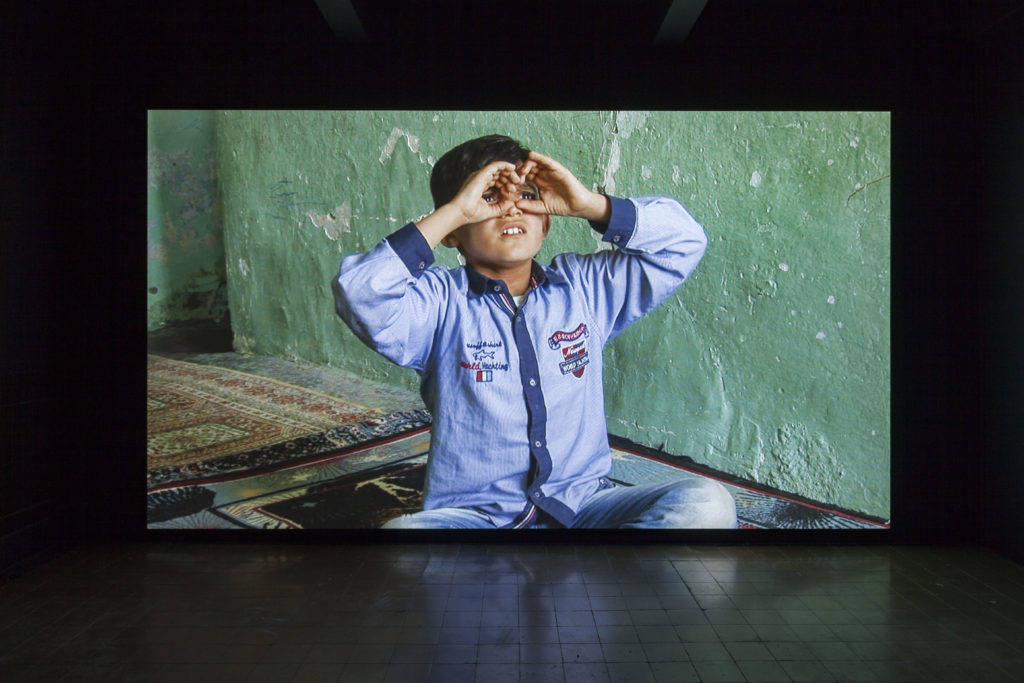
Erkan Özgen, Wonderland, (2016). 15th Istanbul Biennale, Courtesy of the artist Presented with the support of SAHA – Supporting Contemporary Art from Turkey. Photo by Sahir Uğur Eren.
Entering another room through a porta-potty cut through the middle, viewers walk into the crowded junk-yard-like spaces in the installation by Jonah Freeman & Justin Lowe. A sharp turn suddenly leads into what looks like a luxury retail space, its shelves and display cases packed with products and decorated cakes with hilariously inventive titles, evincing the specific type of stoner humor. Another corridor leads to a black box showing the video The San San Trilogy (2014-2016), exploring the fictional proposition of one gigantic urban sprawl reaching from San Diego to San Francisco (hence the megapolis’s name San San).
Another classroom in the school is dedicated to the exuberantly detailed drawings of Andrea Joyce Heimer. By giving her colorful figurative panels extremely long titles, the artist tells succinct yet rich and intimate stories about childhood and adolescence, filled with humor, angst, longing, and projected selves.
Works such as hers and Freeman & Lowe’s are important for this otherwise somber biennial, and at times, the other locations in the exhibition suffer from the unbroken seriousness of the works on view.
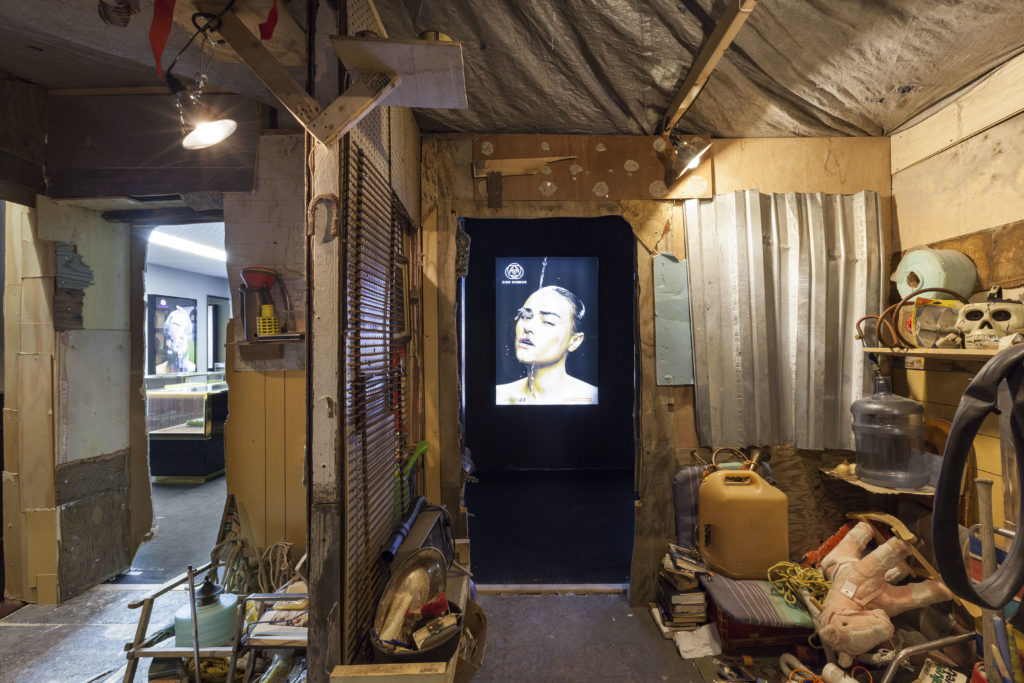
Jonah Freeman & Justin Lowe, Scenario in the Shade, (Detail) (2015–17) Courtesy of the artists and Marlborough Contemporary Photograph Sahir Uğur Eren.
The Istanbul Modern museum, located within a sprawling waterfront development complex, is said to be slated for demolition, and possibly be replaced with a Renzo Piano-designed museum more in line with the investors’ vision. It’s possible that the location’s contested fate may have effected the selection of works on view, and their combined effect of bleakness. (Rarely did an installation by Klara Líden feel as ominous as it does here.) This location also includes a few of the biennial’s more curious selections, including a work by Xiao Yu, Ground (2014/17) that includes a live donkey and two Chinese farmers ploughing a plot of cement by the museum’s entrance.
Inside, the first work one encounters is Adel Abdessemed’s Cri (2013), a difficult piece that takes the iconic image of Phan Thi Kim Phuc, better known as the Napalm Girl, and renders her haunting naked figure in ivory. For this viewer, the argument that an additional layer of meaning and value is given to the photojournalistic image of the horrors of war by this extreme object remained unconvincing.
(A set of answers had been prepared in advance to uneasy questions repeatedly posed by journalists regarding the conditions of working in Turkey, boycotts, censorship, and the arms-dealing activities of Koç Holding, the biennial’s major sponsor, as well as the inclusion of several live animals in the show and this ivory sculpture. “These artworks in the Biennial arise from a longing to form a relationship based on equality with other inhabitants of our planet” was the reply, for example, to critical questions about the works featuring animals and ivory.)
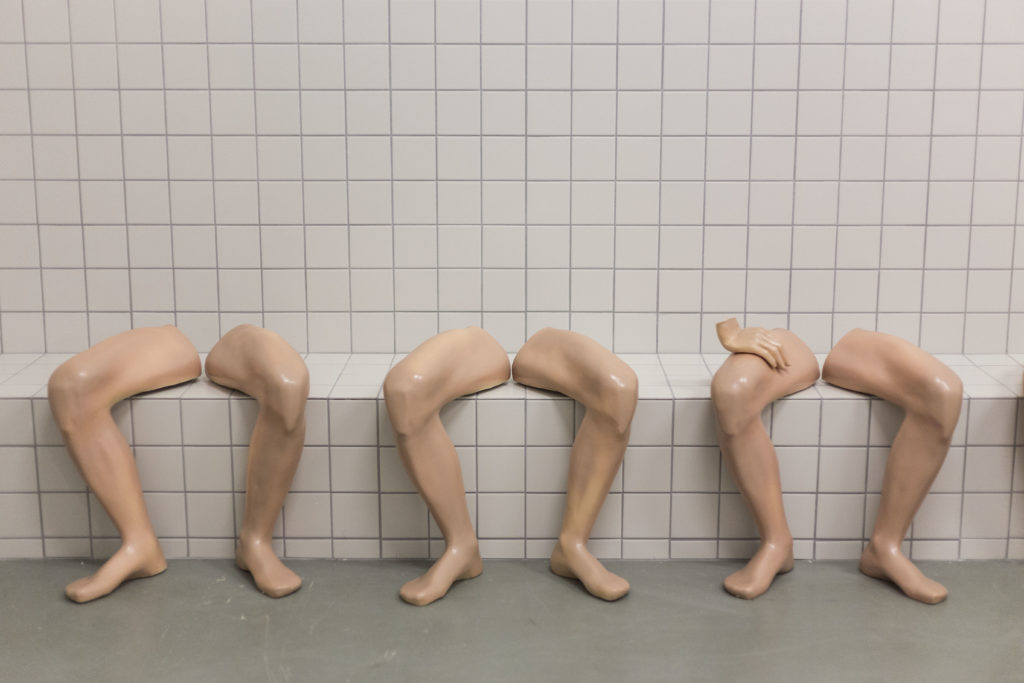
Candeger Furtun, Untitled (1994-96), Installation view at the 15th Istanbul Biennale, Courtesy of the artist Presented with the support of SAHA – Supporting Contemporary Art from Turkey. Photograph: Sahir Uğur Eren
Art works whose political content is more directly related to the realities in Turkey tend to be more visually subtle, and many of them are found in the Pera Museum. The need to give a piece multiple layers to sneak in more critical messages is evident in Gözde Ilkin’s series of embroidered textile pieces, Inverted Home (2017). Melding patterned domestic fabrics with embroidered figures culled from photographs, the Turkish artist addresses issues of self-censorship, performativity in public space, and the oppression of prescribed roles, among other things.
In fact, many works in the exhibition deal with gender and sexual identities, and one location, a Bauhaus-style villa housing the cultural space Arc Kultur, is entirely dedicated to one work by Mahmoud Khaled, titled Proposal for a House Museum of an Unknown Crying Man, (2017). Kahled, using narrative devices reminiscent of the curators’, weaves a story about the reclusive and secretive man who inhabited the house. An audio guide leads viewers thought this suggested museum and through carefully selected personal effects, the artist connects the man’s imagined life with the report released by Human Rights Watch in 2004, titled “In a Time of Torture,” describing Egypt’s crackdown on homosexual conduct.
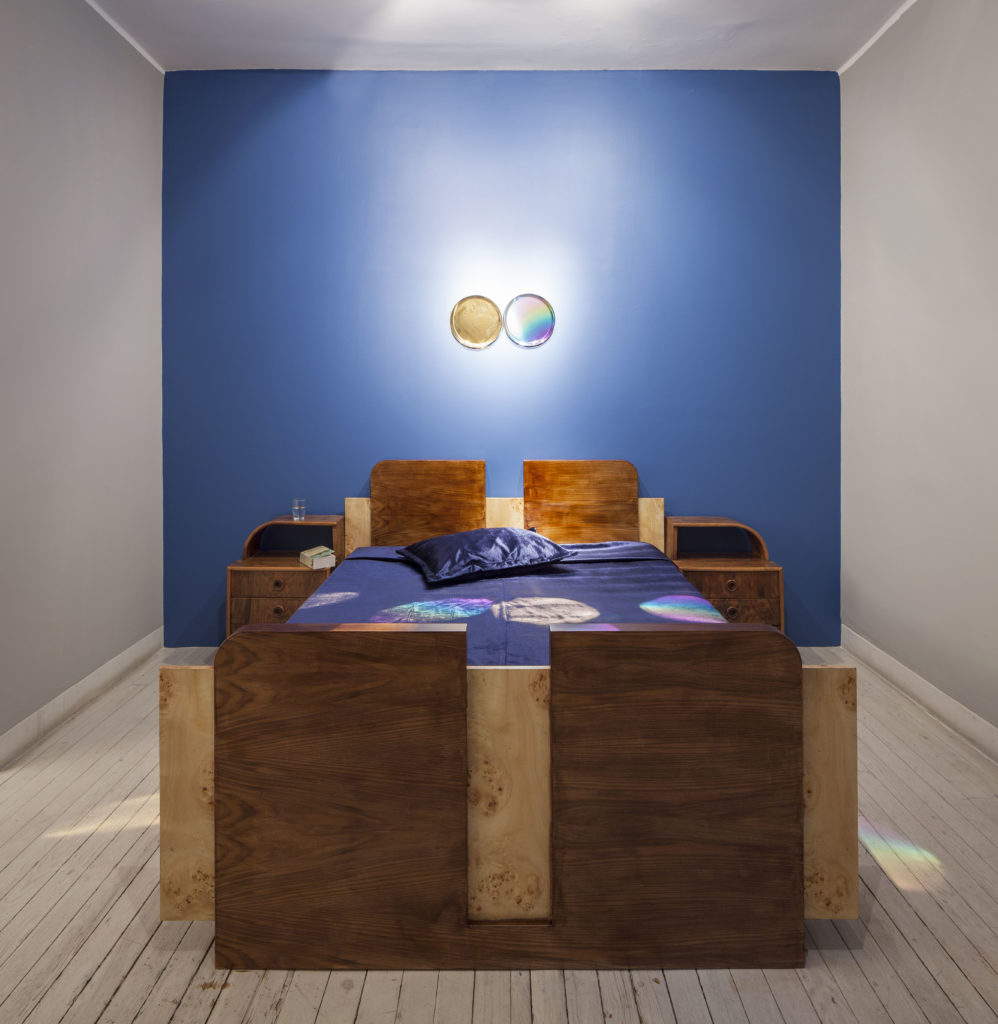
Mahmoud Khaled, Proposal for a House Museum of an Unknown Crying Man, (2017). Courtesy of the artist Produced with the support of Arts Council Norway, Ari Meşulam and Office for Contemporary Art Norway. Photograph Sahir Uğur Eren.
In their highly aware and engaged decisions, Elmgreen & Dragset prompt both artists and viewers to think about the role of art, the spaces it fills, and what can be expected of it in politically fraught times. It is a twisted coincidence that two days before the biennial’s public opening, news came out of Turkey’s signing a landmark missile deal with Russia, pointing to president Recep Tayyip Erdogan’s clear pivot away from NATO and Europe, and with it, to concerns about the strained and fragile coexistence of neighboring peoples along the country’s borders.
The 15th Istanbul Biennial, “a good neighbor,” is free and open to the public from September 16 to November 12.
It is on view at Galata Greek Primary School, Istanbul Modern, Pera Museum, ARK Kültür, Yoğunluk Atelier, and Küçük Mustafa Paşa Hammam in Istanbul, Turkey.